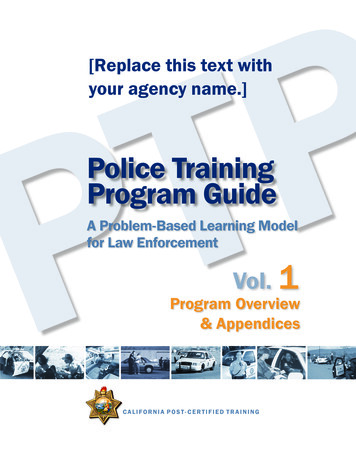
Transcription
[Replace this text withyour agency name.]Police TrainingProgram GuideA Problem-Based Learning Modelfor Law EnforcementVol. 1Program Overview& AppendicesCALIFORNIA POS T- CE RTIFIE D TR AINING
Intentionally blank
[Replace this text withyour agency name.]Police Training Program GuidePolice Training OfficerProblem-Based Learning ModelVolume 1: Overview & AppendicesCompanion Guide toVolume 2: Training Workbook – All PhasesDeveloped byPOST Basic Training BureauCALIFORNIA COMMISSION ON PEACE OFFICER STANDARDS AND TRAINING
POLICE TRAINING PROGRAM GUIDEPOLICE TRAINING OFFICER / PROBLEM-BASED LEARNING MODELVOLUME 1: PROGRAM OVERVIEW & APPENDICES California Commission on Peace Officer Standards and TrainingCopyright September 2014All rights reserved. This publication may not be reproduced, in whole or in part, in anyform or by any means electronic or mechanical or by any information storage andretrieval system now known or hereafter invented, without prior written permissionof the California Commission on Peace Officer Standards and Training. This publication(and any videos associated with it) may not be posted to any web site or social mediaapplication, including Facebook, YouTube, Twitter, or any future social mediaapplication.There are two exceptions: California law enforcement agencies in the POST peace officer program andPOST-certified training presenters are hereby given permission by POST toreproduce any or all of the contents of this manual for their internal use only.However, distribution may be limited. Individuals are allowed to download POST publications for personal use only.(Distribution is not allowed.)Infringement of the copyright protection law and the provisions expressed here and onthe POST website under Copyright/Trademark Protection will be pursued in a court oflaw. Questions about copyright protection of this publication and exceptions may bedirected to the Publications Manager.POST2010BTB-0401-Awww.post.ca.gov
POST Mission StatementThe mission of the California Commission on Peace Officer Standards and Training is tocontinually enhance the professionalism of California’s law enforcement in servingits communities.
POLICE TRAINING PROGRAM (PTP) GUIDEIntentionally blank
PTO/PBLE MODELPOST CommissionersJoyce DudleyCHAIRRick BrazielVICE-CHAIRAlan BarcelonaEve BergLai Lai BuiBarry DonelanDistrict AttorneySanta Barbara CountyEducatorHumboldt State UniversitySpecial AgentDepartment of JusticeChiefTorrance Police DepartmentSergeantSacramento Police DepartmentSergeantOakland Police DepartmentRobert T. DoyleSheriffMarin CountyP. Lamont EwellPublic MemberGeoff LongPublic MemberJohn McMahonJethroe Moore, IIJames O’RourkeBatine RamirezSheriffSan Bernardino CountyPublic MemberSergeantCalifornia Highway PatrolSergeantPlacer County Sheriff’s DepartmentLaurie SmithSheriffSanta Clara CountyMichael TubbsMayor of StocktonWalt VasquezEdward MedranoChief, La Mesa Police DepartmentEx Officio MemberRepresenting Xavier Becerra AttorneyGeneralVOL 1 . PROGRAM OVERVIEWi
POLICE TRAINING PROGRAM(PTP) GUIDEIntentionally Blankii
PTO/PBLE MODELAcknowledgmentsSpecial thanks to:POLICE TRAINING ADVISORY COUNCILFIELD TRAINING PILOT AGENCIES Capitola Police Department Concord Police Department Cypress Police Department Folsom Police Department Fresno Police Department Fresno County Sheriff’s OfficePOST BUREAUS Training Program Services Administrative ServicesVOL1 . PROGRAM OVERVIEWIII
POLICE TRAINING PROGRAM(PTP) GUIDEIntentionally Blankiv
PTO/PBLE MODELForewordBy POST Executive Director Manuel Alvarez Jr.The purpose of the POST Police Training Program Guide is to provide administrators of POST-participating agencies with information and assistance in applying POST field training program regulations withintheir police training program. This standardized program and forms guide law enforcement departments andPolice Training Officers (PTOs) through initial orientation and training of newly assigned patrol officers. Thisprogram assists new officers in the1 transition from what they learned in the academy to performing general lawenforcement uniformed patrol duties competently in the field.The Police Training Program (PTP) was designed in 1999 as an alternative to the Field Training Program (FTP) modelthrough a grant funded by the Department of Justice Office of Community Policing Services (COPS). Californiaapproved the PTP as an alternate training method in 2007. The PTP employs current adult learning theory,particularly Problem-Based Learning, as the primary method of instruction. Using phased training (called SubstantiveTopic Phases), Journaling as a learning tool, and focusing on Core Competencies, the PTP is intended to developproblem-solving skills and engage peace officers in the communities they serve.The goals of the PTP include: To formulate learning opportunities for new officers who meet or exceed the training needs of the agency. To develop and enhance the trainee’s learning from the academy within the community environmentthrough a series of real-life, problem-solving activities. To foster a growing independence from the training officer over the course of the program. To produce graduates of the training program who are capable of providing responsible, communityfocused police services. To prepare trainees to use a problem-solving approach throughout their careers by employing problembased learning. To promote the practice of using community members as partners in problem-solving. To design fair and consistent evaluations that address a trainee’s skills, knowledge, application, and abilityto problem-solve effectively.The mission of the California Commission on Peace Officer Standards and Training is to continually enhance theprofessionalism of California law enforcement in serving its communities. The POST Police Training Program Guide,Volumes 1 and 2, have been developed to support this mission, drawing upon statewide and national lawenforcement expertise.The Commission appreciates the contributions made by the Police Training Advisory Council and the Police TrainingProgram (PTP) pilot agencies (Capitola Police Department, Concord Police Department, Cypress Police Department,Folsom Police Department, Fresno Police Department, and Fresno County Sheriff’s Office) in providing input toprepare this guide. Questions or comments regarding this document should be directed to the Basic Training Bureauat (916) 227-4252.VOL1 . PROGRAM OVERVIEWV
POLICE TRAINING PROGRAM(PTP) GUIDEIntentionally Blankvi
PTO/PBLE MODELCode of EthicsAs a law enforcement officer, my fundamental duty is to serve; to safeguard lives andproperty; to protect the innocent against deception, the weak against oppression or intimidation, and thepeaceful against violence or disorder; and to respect the Constitutional rights of all to liberty, equality and justice.I will keep my private life unsullied as an example to all; maintain courageous calm in the face ofdanger, scorn, or ridicule; develop self-restraint; and be constantly mindful of the welfare of others. Honest inthought and deed in both my personal and official life, I will be exemplary in obeying the laws of the land and theregulations of my department. Whatever I see or hear of a confidential nature or that is confided to me in myofficial capacity will be kept ever secret unless revelation is necessary in the performance of my duty.I will never act officiously or permit personal feelings, prejudices, animosities or friendships toinfluence my decisions. With no compromise for crime and with relentless prosecution of criminals, I will enforcethe law courteously and appropriately without fear or favor, malice or ill will, never employing unnecessary forceor violence and never accepting gratuities.I recognize the badge of my office as a symbol of public faith, and I accept it as a public trust to beheld so long as I am true to the ethics of the police service. I will constantly strive to achieve these objectives andideals, dedicating myself before God1 to my chosen profession.law enforcement.FOOTNOTE:¹Reference to religious affirmation may be omitted where objected to by the officer.VOL1 . PROGRAM OVERVIEWVII
POLICE TRAINING PROGRAM(PTP) GUIDEIntentionally Blankviii
PTO/PBLE MODELAgency Perspective[Replace this text with your agency's perspective.]VOL1 . PROGRAM OVERVIEWIX
POLICE TRAINING PROGRAM(PTP) GUIDEIntentionally Blankx
PTO/PBLE MODELAgency Mission & ValuesMISSION STATEMENT[Replace this text with your agency's perspective.]DEPARTMENT VALUES[Replace this text with your agency's perspective.]VOL1 . PROGRAM OVERVIEWXI
POLICE TRAINING PROGRAM(PTP) GUIDEIntentionally Blankxii
PTO/PBLE MODELContentsFOREWORD BY POST EXECUTIVE DIRECTOR . VCODE OF ETHICS . VIIAGENCY PERSPECTIVE . IXAGENCY MISSION & VALUES . XIAGENCY PROGRAM MANAGEMENT . XVIIGLOSSARY . XXIIIINTRODUCTION . XXV Program Objectives . XXV COPPS’ Influence on the California Police Training Program . XXV The Problem-Based Learning (PBL) Model . XXVIINSIDE VOLUME 1Chapter 1Police Training Program (PTP) Philosophy .1-3 Problem-Based Learning (PBL) .1-3 Ill-Structured Problems .1-3 Teaching Techniques in Problem-Based Learning .1-4 Failing Forward .1-4 Problem-Based Learning Exercises (PBLEs) .1-5 Using Problem-Based Learning Exercises as a Teaching Method .1-6 Duties and Responsibilities .1-7 Personnel .1-7 Trainee Responsibilities .1-9Chapter 2The Learning Process.2-3 Introduction .2-3 The Learning Matrix .2-3 Substantive Topics .2-3 Core Competencies .2-4 Focus Activities .2-4 Performance Outcomes .2-4 Resource Materials .2-4 Applying the Learning Matrix.2-6 Program Phases .2-6 Integration/Orientation Period .2-6 1. Orientation .2-7 2. Introduce Trainees to the PTP .2-7 3. Introduce Learning Activity Packages (LAPs) .2-7 4. Introduce Agency-Specific Components .2-7 Phased Training Options .2-7 Solo Patrol Assignment .2-8 Trainee Journaling.2-8 PTO Training Progress Notes .2-10 Coaching and Evaluation Process .2-10 Neighborhood Portfolio Exercises (NPEs) .2-10 Problem-Based Learning Exercises (PBLEs) .2-11VOL1 . PROGRAM OVERVIEWXIII
POLICE TRAINING PROGRAM(PTP) GUIDEI N S I D E V O L U M E 1 continued Learning Activity Packages (LAPs) . 2-11Prescriptive Training . 2-12Mid-Term Evaluation . 2-12Final Evaluation . 2-12Competency Attestation . 2-13Chapter 3Mid-Term Evaluation and Matrix Performance Outcomes . 3-3 Mid-Term Evaluation . 3-3 Matrix Performance Outcomes: Phases A and B . 3-4Chapter 4Final Evaluation and Matrix Performance Outcomes . 4-1 Final Evaluation . 4-3 Matrix Performance Outcomes: All Phases (A,B,C,D) . 4-4TABLES / FIG URESTable 1.0Police Training Program Overview. xixTable 1.1Police Training Program Model . 1-6Table 2.1The Learning Matrix Grid . 2-5Table 3.1Evaluation Chart: Mid-Term . 3-3Table 4.1Evaluation Chart: Final . 4-3Table A.1Patrol Training Program Timeline . A-13Figure 1.0Police Training Program (PTP) Phases . xxiAPPENDICES (A–O)AProblem-Based Learning Exercise (PBLE) Guideline – SAMPLE FORM . A-3PBLE Scenarios:A.1PBLE #1 – Vehicle Stop (Phase A: Non-Emergency Incident Response) . A-5A.2PBLE #2 – Disorderly at Bar Radio Call (Phase B: Emergency Incident Response) . A-7A.3PBLE #3 – Disorderly Youths in Park (Phase C: Patrol Activities) . A-9A.4PBLE #4 – Domestic Dispute (Phase D: Criminal Investigation) . A-11See Volume 2: Training Workbook for complete set of PBLEs (Exercises 1–4)BPatrol Training Program Timeline (Table A.1) . A-13CProblem-Based Learning Exercise – Completed – SAMPLE FORM . A-15DRubric Assessment for Neighborhood Portfolio Exercise (NPE) . A-17EPrescriptive Training Report (for Trainee Smith) – EXAMPLE . A-21xiv
PTO/PBLE MODELI N S I D E V O L U M E 1 continuedFPTP Trainee Evaluation Report (Mid-Term / Final) – SAMPLE FORM (and Supplemental Page) . A-25GLearning Activity Packages (LAPs) – EXAMPLES . A-31LAP 1LAP 2LAP 3LAP 4LAP 5Problem-Based Learning . A-31Problem-Oriented Policing (POP) . A-33Community Policing . A-35Field Interrogations: Stop and Frisk. A-37Custodial Interrogations: Miranda Warnings . A-39HPOST’s Minimum Content Areas for Training Manuals . A-41IPTP Completion Record / Competency Attestation . A-43JPTP Mid-Term Performance Outcome Goals: Phases A & B . A-45Phase APhase BKNon-Emergency Incident Response . A-45Emergency Incident Response . A-49PTP Final Performance Outcome Goals: Phases C & D . A-53Phase CPhase DPatrol Activities . A-53Criminal Investigations . A-57LPTP Field Training Application and Approval Checklist . A-61POST Form 2-229 Field Training Application (link to POST online form) . A-61POST Form 2-230 Field Training Program Checklist (link to POST online form). A-61MPolice Training Program: Police Training Officer (PTO) Critique Form – SAMPLE FORM . A-63NPolice Training Program: Program Critique Form – SAMPLE FORM . A-67OPTP Agency Orientation / Department Policies – EXAMPLE . A-71VOL1 . PROGRAM OVERVIEWXV
POLICE TRAINING PROGRAM(PTP) GUIDEIntentionally Blankxvi
PTO/PBLE MODELAgency Program Management[Replace this text with your agency's perspective.]VOL1 . PROGRAM OVERVIEWXVII
POLICE TRAINING PROGRAM(PTP) GUIDEIntentionally Blankxviii
PTO/PBLE MODELTable 1.0POLICE TRAINING PROGRAM (PTP) OVERVIEW*The first week is the integration/orientation period for PTO and trainee.NOTE: Click on specific activity or mid-term or final evaluation for additional information.VOL1 . PROGRAM OVERVIEWXIX
POLICE TRAINING PROGRAM(PTP) GUIDEIntentionally Blankxx
PTO/PBLE MODELFigure 1.0POLICE TRAINING PROGRAM (PTP) PHASESINTEGRATION/ORIENTATIONPTO & TraineePHASE APHASE BNon-EmergencyIncident ResponseEmergencyIncident ResponseTrainee & PTOTrainee & PTOPrescriptiveTrainingMID-TERMEVALUATIONTrainee & PTEPHASE DPHASE CTrainee & PTOTrainee & veTrainingFINALEVALUATIONTrainee & PTEEXIT INTERVIEWProgramCompletionTrainee & BOEVOL 1 . PROGRAM OVERVIEWxxi
POLICE TRAINING PROGRAM(PTP) GUIDEIntentionally Blankxxii
PTO/PBLE MODELGlossaryBelow is a list of abbreviations, terms, and acronyms used throughout the manual:BOEBoard of EvaluatorsCOPPSCommunity-Oriented Policing and Problem-SolvingCPTEDCrime Prevention through Environmental DesignEIEmotional IntelligenceFSField SupervisorFTOField Training Officer (Field Training Program – comparable to PTO)LAPLearning Activity PackageNPENeighborhood Portfolio ExercisePBLProblem-Based LearningPBLEProblem-Based Learning ExercisePOPProblem-Oriented PolicingPTEPolice Training EvaluatorPTOPolice Training OfficerPTPPolice Training ProgramPTP SACPolice Training Program Supervisor/Administrator/CoordinatorVOL1 . PROGRAM OVERVIEWXXIII
POLICE TRAINING PROGRAM(PTP) GUIDEIntentionally Blankxxiv
PTO/PBLE MODELIntroductionPROGRAM OBJECTIVES To formulate learning opportunities for new officers/deputies who meet or exceed the trainingneeds of the agency. To develop and enhance the trainee’s learning from the academy within the community environmentthrough a series of real-life, problem-solving activities. To foster a growing independence from the training officer over the course of the program. To produce graduates of the training program who are capable of providing responsible, communityfocused police services. To prepare trainees to use a problem-solving approach throughout their careers by employingproblem-based learning training. To promote the practice of using community members as partners in problem-solving. To design fair and consistent evaluations that address a trainee’s skills, knowledge, application, andability to problem-solve effectively.COPPS’ INFLUENCE ON THE CALIFORNIA POLICE TRAINING PROGRAMCommunity-Oriented Policing and Problem-Solving (COPPS) is a philosophy and daily practice of progressive policeagencies around the world; problem-solving lies at the heart of contemporary policing. The problem-solvingprocess strikes at the roots of crime, rather than hacks at its branches. It provides officers/deputies with a morecomprehensive understanding of problems through in-depth analysis and guides them in the development oftailored and collaborative response strategies.Police administrators are recognizing the ineffectiveness of incident-driven policing, as well as the economicinsensibility of random patrol, rapid response, and post-crime investigation. Responding to the same domesticdispute nightly or citing the same disorderly youths gathering in a park are ineffective strategies that fail to resolvethe problems and simply waste community resources.A common concern voiced by police executives in the implementation of COPPS involves training, especially thetraining of new officers/deputies. This manual presents a Police Training Program (PTP) for training new officers/deputies, which incorporates contemporary adult educational methods and a version of Problem-Based Learning(PBL) adapted for police. This approach to training provides a foundation for life-long learning that prepares thenew officer/deputy for the complexities of policing today and in the future.This program focuses on the officer’s/deputy’s learning capacity and problem-solving skills as opposed to roteperformance capabilities. The program offers agencies an invaluable tool for teaching trainees to perform theirduties and responsibilities in an efficient, effective, and equitable manner.During the Community-Oriented Policing Services (COPS) Office research for this National Police Training Officer(PTO) Program, police administrators and training practitioners identified two primary issues with current fieldtraining programs: lack of fundamental change and protection against liability. There was strong criticism that fieldtraining programs had not changed significantly over the past 30 years in spite of an array of educational andpolicing advancementsVOL1 . PROGRAM OVERVIEWXXV
POLICE TRAINING PROGRAM(PTP) GUIDEThe second issue expressed by police executives was protection from liability. Legal research shows that policeagencies’ concern about liabilities is largely unfounded. There have been very few court cases which justify a focuson documentation and evaluation. An emphasis on training reaps more benefits and provides the protectionagainst liability that agencies continue to seek. In short, this program speaks to identified themes, incorporatingcontemporary COPPS concepts and guarding against liability through emphasis on training.THE PROBLEM-BASED LEARNING (PBL) MODELResearchers and police practitioners, in conjunction with the COPS Office, identified key aspects of a modernizedtraining program. Training officers, administrators, and other police officers from across the country participatedin all stages of program development. Meetings with experts from various disciplines, a nationwide survey of over400 police agencies, and review of dozens of police training manuals took place. Researchers examined fieldtraining systems from numerous police agencies across the United States and Canada.The PBL model is based on the teaching principles of Problem-Based Learning and emphasizes the need for thePolice Training Officer (PTO) to function primarily as a trainer rather than as an evaluator. PBL is well-grounded inthe fields of medicine and education, where it is used to facilitate the transfer of knowledge.Similarly, in policing, trainees need to learn much more than just laws and police procedures. They must alsounderstand how to apply their academy knowledge effectively when dealing with individuals and issues within acommunity.As demands on police continue to increase, agencies must provide officers with the resources and the trainingnecessary to fulfill their expanded role. It makes good sense to have police trainees thinking about their roles andresponsibilities as they approach specific problems in their daily work. Problem-solving is an integral part of policework and requires a creative and flexible method of thinking. The PBL model Police Training Program encouragesthat flexibility and creativity.This manual represents a compilation of the best aspects of the DOJ-COPS national model, the Reno Model, andthe California pilot of the Police Training Program. The POST PTO Council has prepared this manual for use in theirclassroom instruction and as a resource when training new officers/deputies in the California Police TrainingProgram.xxvi
PTO/PBLE MODELINSIDE THIS CHAPTERChapter 1. Police Training Program (PTP) PhilosophyProblem-Based Learning (PBL) . 1-3Ill-Structured Problems . 1-3Teaching Techniques in Problem-Based Learning .
The Police Training Program (PTP) was designed in 1999 as an alternative to the Field Training Program (FTP) model through a grant funded by the Department of Justice Office of Community Policing Services (COPS). California approved the PTP as an alternate training method in 2007. The PTP employs current adult learning theory,
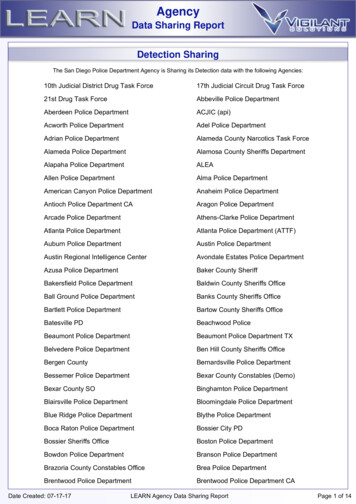

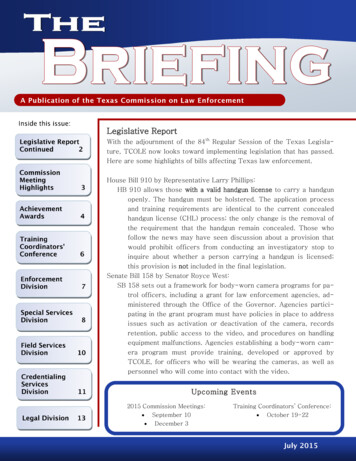




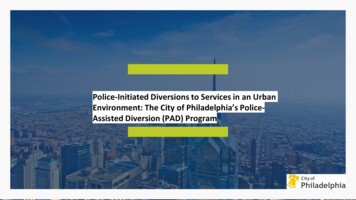
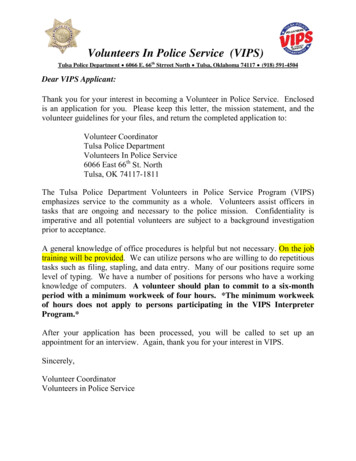
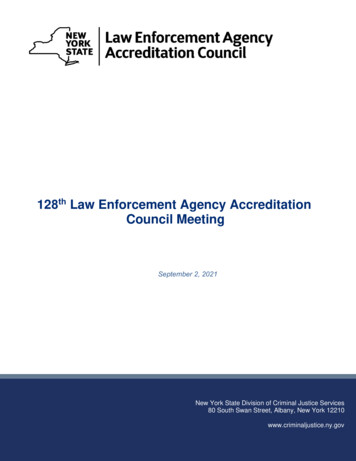
![Vohne Liche Kennels 6SHFLDOL]LQJLQ6WUR QJ6RFLDO3ROLFH'RJVµ](/img/38/reference-listing.jpg)